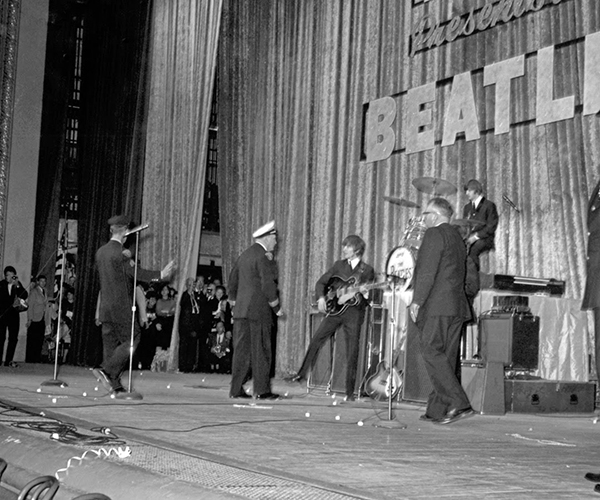When the train rounded the bend, revealing the gleaming Terminal Tower, 11-year-old Bennie Mosley Jr. was awestruck. It was 1948, and the young man was riding up from Alabama to join his father, who had moved to Cleveland for the same reason so many others had in the 1940s — opportunity.
"I was just one day shy of my birthday, and when I got off the train, I had never seen nothing like this place," says Mosley, now 78, who went on to become a social worker in the Hough neighborhood. Used to climbing trees and playing in the open, he was anxious about life in the city and wanted to return to the South.
"It was just this strange place," he recalls. "It was fascinating to see these large buildings."
Today, the Terminal Tower greets new arrivals as part of an expanded skyline, its 708 feet overtaken by taller skyscrapers. But it is no less an icon, standing steadfast as 85 years of Cleveland's civic triumphs and catastrophes swirled around.
"It was a sort of beacon. You knew you were coming to Cleveland when you looked out the window and saw the tower," says John Grabowski, 66, a history professor at Case Western Reserve University and historian at the Western Reserve Historical Society. "As I look at the Terminal complex, it's the city at its apogee."
In the shadow of Terminal Tower is Public Square, 10 acres laid out by Moses Cleaveland in 1796. Unlike the tower above, the outer facade of which has remained largely unchanged, Public Square has morphed with the priorities of the moment, changing form to fulfill the needs of city administrations, aesthetic standards, and wartime and financial interests.
It began as a prototypical New England town square with public grazing space where sheep roamed. But as the city grew, the square became the center of commerce, a commons encircled by the necessities: banks, hotels, a church and government buildings.
With growth came new priorities. In 1878, the statue of Commodore Oliver Hazard Perry was moved to make way for traffic. The only Public Square statue not to uproot is also its largest — the Soldiers' & Sailors' Monument, opened in 1894.
Progressive mayor Tom Johnson once pitched his speaker's tent, made famous as a forum for free-flowing political discussion, on the square. Embodied there, where his statue will soon sit once again, is Johnson's firm belief in the city as public space.
"What I wanted to convey to the people in my platform [for mayor in 1901] was what I have been trying to make them understand ever since, that the city with its privileges and its responsibilities is their city, that it is as much their home in the collective sense as the houses in which they live are their individual homes," wrote Johnson in his autobiography, My Story.
It seems Cleveland could not contain such greatness — the city's finest mayor died before its most iconic building was constructed. In Johnson's Cleveland, the southeast corner where Terminal Tower now stands was jam-packed with storefronts, from clothes stores that doubled as credit houses to Humphrey's candy shop.
In 1920, pedestrians crowded the streets as signs advertised chewing tobacco and whiskey from above. It was vibrant but did not fit the aspirational vision of the Van Sweringen brothers, who floated a plan to demolish the corner buildings and build the Terminal Tower in 1923.
On June 28, 1930, the tower was dedicated. "High in Transportation and Industry, They Hail Mighty Terminal," praised The Cleveland Press headline. It would prove a siren song.
It took 46 years to propose another remake of the square, a period in which Cleveland's population decline began to take hold, birthing the Rust Belt. That version, proposed in 1976 and completed in 1986, was dedicated on the city's 190th anniversary. This year, it was demolished to make way for another, newer iteration. When completed in 2016, the square will bear some resemblance to its 1796 form, with rolling greenery and limited vehicular traffic.
Like each overhaul before it, the new Public Square portends a reinvented Cleveland — one of youth, bike lanes and juice bars. Above the square, Terminal Tower — ushered into the information age with LED lights and the @TowerLightsCLE Twitter feed — is as much a symbol of our past as our future. The same building that once housed the offices of railroad companies now hosts StartMart, a space built to foster technology companies.
Like Mosley's father, Cleveland still attracts those seeking opportunity. Instead of factories, they are coming for jobs in professional services firms, biotech startups and higher education. They are less in numbers but they are growing, building with keyboards and vials what previous generations eked out with sweat and steel. To them, history is not to be left fallow; it is a present to make new.
"My generation is going to look at the May Co. building and it's going to be the May Co. building, because that's what we saw and remember it as," says Grabowski. "Newer people who are coming into these buildings, they're curious about what it was, but what it is, is what it will be remembered as."



